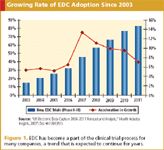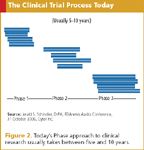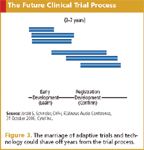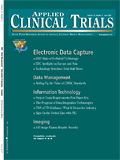The State of E-clinical Technology
E-solutions are on the rise and gaining favor with FDA, as resistance finally gives way.
The rise or fall of a drug substantially affects those who have invested time, capital, health, research, and other related resources. Clinical trials, regulatory matters, current trends, and other associated matters concern all members of the global health care community and, specifically, pharmaceutical and drug development gurus.
For more than a decade, clinical trial experts and practitioners have been in search of a more efficient and effective means of reporting research. Traditional paper reporting methods have revealed their own flaws, including double-data entry inaccuracies, slowed responses to adverse events, and the uncertainty of data reported in a timely manner. Over the years, technology has inched its way toward being recognized as a solution rather than an erratic competitor to paper.

PHOTOGRAPHY: COMSTOCK, JIM SHIVE ILLUSTRATION: PAUL A. BELCI
Current conditions
It's not a new craze. Over time and in recent years, electronic data capture (EDC) and other e-clinical solutions have created a buzz among clinical study sponsors, principal investigators, media, and the pharmaceutical industry as a whole. E-clinical tools and full suites are becoming integral components of clinical trials, as clinical trial sponsors have realized, as with every aspect of technology, that electronic capture of data is efficient and is simply a more sensible and safe means of reporting results than paper reporting methods.
One might wonder why any sponsor might still consider paper reporting if electronic reporting truly provides more accurate and efficient results. E-clinical providers are forced to acknowledge that although electronic solutions may be at the forefront of every sponsor's mind, it might not be at the forefront of actual clinical studies.
E-clinical vendors have heard the rationale before—cost of software, cost of maintenance and implementation, lack of comfort with technology, connectivity barriers, training resources, and more.
Today, almost all information has materialized into electronic records. Theories and concepts are transcribed to computers, numbers are calculated through electronic formulas, and physical labor has been relieved through mechanical apparatus. Technology solutions have become rapidly and widely accepted on a global scale. So, why are e-clinical solutions incurring such a slow adoption rate, and what will it take to get all clinical trial sponsors to adopt this technology?
Electronic reporting and PROs
Certain clinical activities have traditionally been conducted the same way for more than half a century. For instance, paper-based patient-reported outcomes (PRO) have been used for decades to gauge quality-of-life results associated with treatments. After evaluating the accuracy and credibility of paper-based PROs, researchers began to find that paper questionnaires and reporting encompass some influential limitations on trials, such as false or fabricated information and other ambiguities. Late or missed entries cannot be tracked through paper reporting methods, and the timeliness of entry, or lack of, may drastically impact the assessment of efficacy and validity of hypotheses developed by data managers and investigators.
Electronically captured PROs, referred to as ePROs, will ultimately bring safer drugs to market faster, increase post-marketing accuracy, and protect the health of clinical trial patients prior to and post approval, with the consideration of physical and mental components of clinical trial effects added to the equation. Adverse events and other safety issues can be immediately relayed to monitors and site personnel.
Again, with this in mind, the industry is forced to examine why all trials are not yet conducted using technology solutions such as eDiary, interactive voice response (IVR) or EDC, especially if they are in the best interest of patients.
Regulatory matters
Over time, industry concerns began to surface surrounding data management and knowledge sharing, both of which have gained increased attention and momentum over the past year. To rectify this problem, many e-clinical vendors began offering role-based access to data to limit inaccuracies and unnecessary access and to maintain confidentiality.
Three years ago, in March 2004, the FDA released a white paper entitled "Innovation or Stagnation? Challenge and Opportunity on the Critical Path to New Medical Products."1 The paper focused on the notion that all tools used in the drug development process, specifically evaluative tools, need to be moderated and updated. The FDA suggested that the pharmaceutical industry's methods of data collection, throughout all phases of the clinical trial process, were antiquated.
Since the release of that white paper, the FDA developed the "Critical Path Opportunities Report and List,"2 which served as a report on progress made on the Critical Path Initiative through 2006. The report stated that drug development initiatives have increasingly implemented technology solutions as a means of streamlining processes, improving predictability, and decreasing overall cost. With regulators relying more heavily on technology as a means to enhance drug development, the pharmaceutical industry has been forced to consider technology as a central solution to clinical trials.
To place additional emphasis on relying on technology as a solution in drug development processes, the FDA released a draft guidance in February 2006 entitled "Patient-Reported Outcome Measures: Use in Medical Product Development to Support Labeling Claims." In this document, the FDA considered the value of e-clinical technology to support PROs through the outline of specific concerns regarding ePRO instruments such as the following:
The use of electronic PRO instruments...may pose a problem if direct control over source data is maintained by the sponsor or the contract research organization and not by the clinical investigator. The FDA considers the investigator to have met his or her responsibility when the investigator retains the ability to control and provide access to the records that serve as the electronic source documentation for the purpose of an FDA inspection. The FDA recommends that the study protocol, or a separate document, clearly specify how the electronic PRO source data will be maintained.3
The FDA's address to clinical sponsors who utilize ePRO instruments is a testament to the significance of the application. Electronic versions of PROs, data capture, data management, and reporting are changing the clinical trial process, and regulators are forced to recognize and address these changes.
Adoption rates
Research illustrates that the industry is showing potential on its own through educational-based adoption. According to a Forrester Research report, authored by Laura Ramos, entitled "The Promise of Next-Gen eClinical Trial Software," in 2006 nearly 20% of all clinical trials were performed electronically.4 Experts expect that the use of e-clinical technology saves the industry $60 million per approved drug trial. This figure (actual and opportunity costs) increases tremendously in correlation with technology's ability to fail unsuccessful drugs quicker in the process.
Chris Connor, senior research analyst from Health Industry Insights, predicted EDC software revenues would reach $300 million by the end of 2006.5 In addition, Connor found that the overall usage of EDC in 2006 on new clinical studies rose 32% from 2005 and 25% from 2004.
In the April 6, 2007, issue of Health Industry Insights' newsletter Connor depicts the relative rate of acceleration in the annual growth of EDC adoption.6

Figure 1. EDC has become a part of the clinical trial process for many companies, a trend that is expected to continue for years.
Although start-up costs related to technology implementation tend to be a difficult obstacle to overcome, slowly pharmaceutical and biotech companies are realizing the long-term value of e-clinical trials. From the cost savings of failing fast to the potential global impact of bringing a life-saving drug to market quicker, technology solutions are gaining the respect and trust of the industry. Also, technology transfer agreements through some vendors allow sponsors and CROs to benefit from the efficiencies of subscription-based, software-as-a-service solutions.
E-clinical solutions offer adaptive benefits
It's no surprise that electronic reporting solutions allow for a quicker response rate on behalf of sponsors and investigators. Now e-clinical technologies are enabling the next wave of trial design: adaptive trials.
Electronic data arrives at its final destination much quicker than paper recorded data. As a result of this obvious yet valuable benefit of e-clinical solutions, adaptive trials have naturally been linked to these electronic solutions. EDC and eDiaries allow for automated alert notifications to be implemented, preventing patients from forgetting or delaying the data entry process. Electronic reporting also reduces the likelihood of biased results that paper reporting often produces through delayed registration of adverse effects and undependable documentation that lends itself to inaccurate alterations.
Dr. Michael J. Rosenberg, MPH, founder and CEO of Health Decisions, defined adaptive trials as the following: "The term adaptive research broadly denotes changes that can occur during the course of a study or development program without compromising validity or integrity. An adaptive trial design can correct mistaken assumptions or seize an opportunity to optimize the trial."7
Knowing they will receive trial data electronically in near real time, sponsors are designing adaptive trials that provide flexibility to make changes midstudy if unexpected adverse events occur or if aspects of the study are proving to be inefficient and/or ineffective. An adaptive trial is designed to be modified without starting over.
Cost of development and importance of data accuracy are equally important with regard to study startups; however, patient safety can be the most detrimental factor if not attended to—even in postmarketing. Technology solutions, particularly EDC solutions, take on a vital role in overcoming the challenge of seamlessly integrating clinical data with external data. As the FDA explores the capabilities and benefits of adaptive trials, technology will become a natural partner, if not the leader, of this initiative.
Jerald Schindler, DrPH, president of the pharmaceutical research division at Cytel Inc., gave a presentation in October 20068 in which he listed the following benefits of adaptive trials:
- More efficient processes leading to faster trials
- Midcourse correction capability for trials gone off-target
- Fewer patients enrolled in ineffective treatment arms
- Increased quality of results—more patients enrolled in successful treatments
- Healthier for patients—greater chance of receiving an effective treatment
- Reduced timeline by combining phases
- Reduced costs by stopping unsuccessful trials early.

Figure 2. The current Phase approach to clinical research usually takes between five and 10 years.
Schindler's presentation demonstrates the impact that adaptive designs will have on trials through the use of technology (see Figures 2 and 3). He anticipates that adaptive trials will likely cut the clinical trial process by 30%.

Figure 3. The marriage of adaptive trials and technology could shave off years from the trial process.
Heading into the future
The e-clinical industry has established a presence in the drug development process and will take on an even stronger role as its value proposition is recognized by sponsor companies and as the FDA and other regulators lend their full approval. As previously discussed, EDC has become a common term within the industry; however, its adoption rates are not yet directly correlated to EDC's benefits.
The state of e-clinical solutions is strong, but there is vast room for improvement, adoption, education, and utilization. With the Critical Path Initiative and adaptive trials gaining strength and increasingly being backed by regulators, these solutions have the potential to be the assumed technology solution for all clinical trials, as paper has been for the past 50 years.
John Cline serves on the Board of Directors for etrials Worldwide, 4000 Aerial Center Parkway, Morrisville, NC 27560.
References
1. Innovation Stagnation: Challenges and Opportunities on the Critical Path to New Medical Products. U.S. Department of Health and Human Services Food and Drug Administration, March 2004, www.fda.gov/oc/initiatives/criticalpath/whitepaper.html.
2. http://www.fda.gov/oc/initiatives/criticalpath/opportunities06.html.
3. Patient-Reported Outcome Measures: Use in Medical Product Development to Support Labeling Claims. U.S. Department of Health and Human Services Food and Drug Administration, February 2006, http://www.fda.gov/cber/gdlns/prolbl.htm#i.
4. L. Ramos, "The Promise of Next-Gen eClinical Trial Software," Forrester Research, March 15, 2006.
5. D. Borfitz, "Forecast: EDC Money-Making Shifts to Phase II Trials," Bio-IT World Magazine, BioPharm Quarterly, December 2006, http://www.biopharm.com/NewsletterQ42006.pdf.
6. C. Connor, "The e-Clinical Singularity," Health Insights & Outlooks, April 6, 2007, http://www.idc.com/downloads/HealthInsightsOutlooks04-06-07.pdf.
7. M. Rosenberg, "Adapting to Adaptive Studies," International Clinical Trials, Spring 2007, pages 23–25.
8. J. Schindler, "Adaptive Clinical Trial Design: How to Lower Costs and Shorten Product Development Cycles," FDAnews Audio Conference, October 31, 2006.

New FDA Initiative Reveals Common Reasons for Drug Application Rejection
July 11th 2025By publishing more than 200 complete response letters, the FDA is offering new visibility into the issues that most often delay drug approvals, including safety concerns, trial design flaws, and manufacturing gaps.
FDA to Launch National Priority Voucher Program to Speed Drug Reviews for Critical Therapies
June 18th 2025Under the new initiative, companies may receive a voucher enabling FDA review to be shortened from the standard 10–12 months to just 1–2 months following final application submission if the drug addresses US national health priorities.
FDA Outlines Updated Requirement for Placebo-Controlled Trials in Vaccine Research
May 21st 2025In an article recently published by The New England Journal of Medicine, FDA higher-ups Vinay Prasad, MD, MPH; and Martin A. Makary, MD, MPH, wrote that any new COVID-19 vaccine must now be evaluated in placebo-controlled studies.